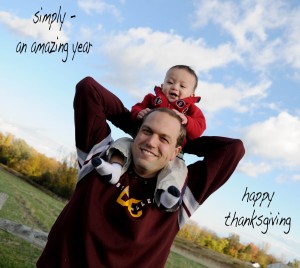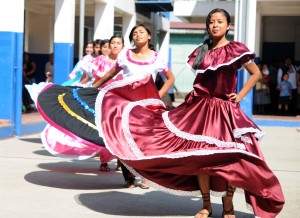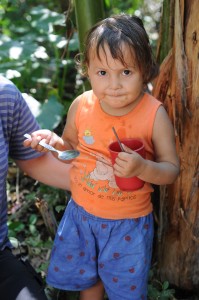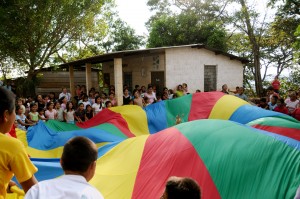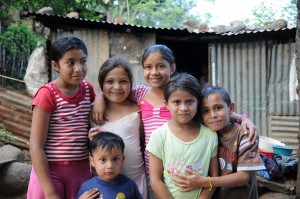So, The BIRD
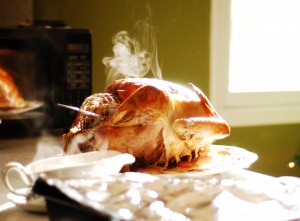 Do you cook a turkey for Thanksgiving?
Do you cook a turkey for Thanksgiving?
Despite my flirtatious relationship with veganism, I do partake in some bird eating on holidays.
But I’m wondering of other ways to celebrate a main course, sans bird.
One vegetarian told me she puts the stuffing in between two pieces of bread and makes a sandwich. To which I asked, “Isn’t stuffing made of bread?”
“Yes,” she confirmed.
“So,” I reasoned slowly, “you’re just having a bread-filled sandwich.”
“It’s a lot of carbs, I realize.” She nodded as if already agreeing with me.
“No, it’s not the carbs, it’s just…a lot of, you know, BREAD.”
Sans bird ideas? Share, share, share!
Love in the Time of Thanksgiving
Last week, I attended mass in El Salvador and the priest was from the United States. He explained to the Salvadoran congregation that in the United States, we have entire day devoted to giving thanks and being grateful for all that we have. What a romantic idea – an entire nation, the only superpower nation, leader of the free world – giving thanks for what we have.
I don’t know how they imagined us – in our homes, at our kitchen or dining room tables giving thanks for the abundance that we have with…more abundance. Thanksgiving, our time to give heartfelt gratitude is celebrated with a splurge of money and resources and goods. AND FOOD. Food like no other day of the year. We eat until our ears are ringing.
This is how we give thanks?
If you look deeper, though, we do try to centralize what is important: togetherness, friendship, family. We try to express the love in our hearts by filling our bellies and slapping each other on the back after not seeing our families for weeks, months…sometimes years.
Despite this rather odd tradition of giving thanks through gluttony, I have really tried to think and act intentionally this year for this holiday. How do I give thanks? Is by cooking that big bird and adding butter to the stuffing? How do I show how grateful I am for my healthy son, how I am still overwhelmed by my uneventful pregnancy and glorious birth experience? How do I express my joy for my husband, our home, our communities, health, faith, and even landscaping?
How do you find love in the time of thanksgiving?
So much of thanksgiving is about other things than thanks. It’s time for Christmas and tradition, but is gratitude, real gratitude incorporated into our traditions? In how we celebrate thanksgiving, do we really give thanks?
The people of El Salvador expressed joy over our visit, exclaiming how blessed they were that we – regular folks with limited Spanish speaking skills – came to visit their homes. They give thanks over flimpsy steel roofs and standing in six inches of mud in the homes during the rainy season. When their sons end up in jail and their spouses are sick on a makeshift cot, they focus on what they do have and are thankful.
This week, I am trying to make use everything I have and take inventory of what I really don’t need, want, or use. For instance, I am beginning with my kitchen. Instead of piling up another cart of food for the upcoming week, I’m trying to cut my own potatoes and bake them instead of buying a bag of chips. Instead of store bought dip, I’m making my own eggplant based baba ganoush. Whatever clothes haven’t been worn in 2 years is being donated. On reasonably dry and cool days, I take my bike or walk instead of the car. Isaiah’s trunk of clothes is going to be raked through and anything that is tripled or quadrupled will be donated.
It’s not about restriction or limiting. It’s about knowing what you want, using it, rejoicing in its function, and letting go of the superfluous.
Love in the time of Thanksgiving is finally letting down my guard and walking over to my neighbor’s house to simply chat. Love in the time of Thanksgiving is letting Nick be uncomfortable in going to the grocery store and allowing myself time to just relax at home. Love in the time of Thanksgiving is going to a zumba class and letting loose. It means being more gentle and accepting that not every mind can be changed, not every heart can be touched, but those who I do come in contact with would never guess that from my actions.
I try to stir my deeper memories, old paintings in my mind of figures and friends long gone. Mrs. Young, my 5th grade teacher who told me I had “such great insights” which led me to write poetry. A woman who talked to me for two hours on a train in 2000 and engaged in such rich conversation that she invited me to visit her in her Washington home. Pamela Tanner Boll, an Oscar winning film director who spent over an hour with me on the phone encouraging me to continue with my writing through the demands and difficulty of new motherhood. The speech therapist I had when I was six years old, albeit she was the scariest person to me at the time, but helped me overcome my lisp. My first surgeon who steadily walked me through the reality of ovarian tumors at age 20.
Love in the time of Thanksgiving is not only celebrating what we have and who we are today, but also humbly remembering all who brought us to our present blessings.
The Physical is the Spiritual! and other things I learned during Zumba class
I smirked at the wildfire spread of zumba, a mix of latin and international music and dance moves used in group fitness classes, and tossed the idea aside. That is, until this morning, when I found myself standing in the second row of a Saturday morning zumba class.
The lights were dimmed, my body was still sore from a kickboxing class a few days previously, and the room was full. I was fairly confident about my dancing skills. I’ve always hidden my natural love of dance and moved in the privacy of my home. As a little girl, the living room was my stage. Years of cheerleading incorporated tumbling and dance classes and now, with my son in a high chair, I turn the music up loud in the kitchen, and dance for him every morning.
It was a room of all women. All ages from teens to late sixties. There were women of nearly every size and color. Women in regular clothes, workout clothes, even Indian dresses. Hair was swept up in ponytails or loose and free. It was like a small sample of the world’s women. The room was wall to wall mirrors and seeing so many women giggling and practicing different dance moves made me smile.
I tried to remember the last time I danced an organized or choreographed dance with a group of people. Probably since my cheerleading days. Sure I danced at weddings and parties, but nothing in sync. I was doubtful on so many levels if I would enjoy it. Would it be a decent workout? Would I be able to to do the moves? Would I look like an idiot?
Bri, the instructor, made it more than a zumba class. She brought in a quote and announced, “Decide to take action!” I wasn’t sure why she was bringing in quotes – even extras for some of us to take with us – when it was just a fitness class. It would soon make sense, but I had my doubts. “Whatever you are carrying with you, let it out,” she kept exclaiming through the warm-up salsa, through an infusion of hip-hop moves, and energized stretches. “Take action and let it out. Say good-bye and do something else instead. You’re here right now, so be here and let it go.”
Zumba started resembling something like a physical therapy session.
For the next fifty minutes, we moved our hips, legs, arms, and shoulders in rotations, thrusts, punches, and swings in a colorful array of I-don’t-even-know-what. But something happened at the halfway point that I could barely believe.
A room full of strangers, all women, sweating and at first stiff with uncertainty, began to laugh, and loosen up. Perhaps it was bumping our cute booties in the air and Bri exclaiming, “Your body is a wonder, shake it up and love it!” in a non-corny kind of way that helped even the oldest of women try to shake their gluteus maximus high in the air. And then she choreographed a dance that had us bunch together and turn to the side mirrors. She stood in the front, dancing, while we followed, “Look at us!” and as we trod and skipped, jumped and flew our limbs, I stopped and stared. It was an amazing sight. All these women, dancing and smiling in sync. Real women with curves. Real women without coordination. Real women with lines and color and left feet and off beats. It was beautiful. We looked like a flock of birds in rhythm.
And something amazing began to happen. I began to feel lighter and beautiful, like the dance. My feet felt happy. My knees were excited for more. And the women around me started yelping and clapping after each song. The moves became more sensual and Bri began to use imaginative stories, “You step wide into the shower and let the water rinse down your body…” and every women in the room got into the image. Their hands moving from the top of their heads to the sides of their torso. Eyes closed, the music throbbing in our veins.
The energy was something whole and pure, physical and sensual. Our bodies weren’t in sync, but they were alive. My skin was damp, my muscles were warm, and my bones flowed in directions it hadn’t moved in for a long time. Through dance, I found myself smiling at everyone around me and finding smiles in return. The physical became the spiritual.
“Decide to take action today. Whatever it is – a fight you want to let go of, a bad decision, an idea you are sitting on – take action and live today.”
The dimmed lights, 25 women, undeniably infectious music, a positive but not overly cheesy dance instructor, and one quote: Decide to take action today.
At the end of class, after smirking at zumba class, and inward doubts about printed out quotes and dimmed lights, I turned out to be one of the women in line waiting to get a copy of the quote.
Letter 15
Dear Isaiah,
There are four major milestones that have occurred in the past two weeks. On Tuesday, November 9, you kneeled in front of the one-step landing which leads to the staircase and, after several minutes of contemplation, climbed your first step on your own. It took some contorting of your chubby limbs and some sliding around, but you did it. Your Dad and I were there to watch you and clapped and cheered when you were finished. You were so excited you bounced for a minute straight. Knowing I was leaving for five days on a trip to El Salvador in the morning, I started crying. Typical.
Sunday, the day I returned from El Salvador, the longest amount of time that I’ve ever been away from you, I asked your Dad if any major milestones happened (I was praying you’d wait to walk or say your first word when I was around), and he excitedly told me, “Today, Isaiah clapped for the first time.” And sure enough, the next day when I led you down a path, luring you to clap after me, you patted your little hands together in not the loudest clap, but a bona fide smack of two palms meetings.
Yesterday, Saturday, after a whole day of watching you crawl and then straightening your legs like you were in a yoga downward dog position, you waited for an occupied moment. Your Tita Carmen, Dad, and I were all laughing, talking about the wedding, and upcoming plans. It was then you noticed a very shiny, a very unusual looking object in my hand: a beer bottle. And it became so fascinating to you that you just had to touch it. And you grabbed and grabbed and grabbed. I was so concerned about you licking a drop of my cider beer and the clear detriment it would have on your development that I nearly missed an important question softly blinking in the back of my mind: How is he able to reach my bottle while I’m sitting on the couch?
YOU STOOD UP.
And it was then I freaked out and yelped at Nick and your Tita, “Do you see him? Are you watching? Can you believe it?”
And there it was, there you were, leaning up against the couch, standing for the first time like you truly, really, genuinely wanted something. It was a beer bottle.
Finally, the last milestone, which was the most stunning of all progressions happened quite randomly and I’m glad there were witnesses because, otherwise, no one would have believed me. Tuesday, I brought you into work and when we were getting ready to leave, with four co-workers waving goodbye, you extended your little arm and bopped it up and down and responded to my friend Marie with, “BAH BYE!”
Silence. Complete and utter silence. We were shocked. We just witnessed your first word, and in my thrill didn’t really mind it wasn’t “mom” and to hear you make an association between your verbal ability and a physical motion was just out of this world. Truly.
So, today, on your 11 month birthday, I can only marvel at your growth. It feels like each passing day comes with endless riddles of guessing what might happen today, what might shock those around you, what might someone miss if they are not with you. So, Isaiah, these days I am grateful to the heavens above that I am with you. That I have a place in the world that allows me to work and watch you grown. Be with you, hold you, scream for your Dad upstairs the seconds before you conquer your first step, widen my eyes at my co-workers after your first words, and nearly spill my beer all over your head in ecstacy when you stand, and clap like a fool when I am ridiculously proud of you for learning to put your hands together. For every moment that I witness your little life building with strength and accomplishment, I say litanies of gratitude.
Eleven months doesn’t seem quite possible, but, then again, neither does that wondrous amount of goodness and love you have brought to our family.
Love,
Mama
When ‘More’ is Less: The Mistakes of Creating Fem/icons
Early this week, I returned to the United States to find More magazine running a feature on the new feminist faces and find the majority of them fair(er) skinned, dimploma-ed, English speaking, internet-friendly activists. I shake my head at the latest case of mainstream feminism’s narcissistic identity crisis, led or diagnosed primarily by US-centric feminists who love to throw the limelight on the academically inclined and computer savvy.
So in More’s latest round of THE US AMERICAN’S NEXT TOP FEMINIST, I read that nearly all of these feminists were being identified because of their web presence, or published works, or education/professional status, or defining leadership in a she’s-the-founder/dot org kind of way. Not that the work of these women should be ignored, but even Miriam Perez, one of the featured feminists, wrote that she was included in this list probably because she knows and is friends with another featured feminist. Which means, as long as we associate with certain types of “feminists,” our work will be acknowledged as well. Or deemed important. Or distributed throughout media. This is More’s way of defining leadership?
And what exactly does this kind of profiling do? Does it celebrate the accomplishments of women, everyday women, women who do not identify feminist but who dedicate their *lives* for the advancement of women outside internet, academic, and professional settings? How and why has feminism become so pinky-up that the background for a feminist leaders photoshoot takes place in what resembles a vacated hotel lobby instead of the actual battlegrounds of gender injustice? The trenches don’t look like that from my perspective. If this is how feminism looks, I must be in the wrong movement.
Instead of media uplifting the grassroots efforts, the everyday actions of extraordinary women and women identified individuals, it relentlessly chooses to uplift the same and profile the same kinds of leadership within feminist identified communities. And for a movement that supposedly is for the advancement of ALL women, we sure do spend an awful lot amount of time congratulating the same kinds of folks over and over again. Perhaps it is not these fifteen women who need a magazine spread, but a feature redefining the meaning of feminist leadership in the context of our global society would be more helpful.
I work with make/shift magazine. I assist with their profiling section and know first hand that it is Hard effing Work to find the visionaries and brave souls out there doing and BEING the work, and profiling them for the world to know about. It’s a lot of research, a ton of time, and plenty of false leads. But they’re out there and it’s about being dedicated to the organizations and people who are not in it for fame, money, press, or numbers. It’s about understanding that feminism is about shifting, not sameness.
So, here’s a handful of people who I think are doing pretty damn important work out in the world…
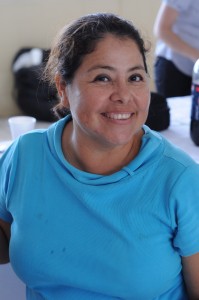 This is Roxanna. I met her last week in El Salvador as she worked as an interpreter and guide into the mountains of Chiltiupan. She and I talked in both English and Spanish, swapped stories about our jobs, love lives, families, and perspectives. With her smile and voice, she helped organize hundreds of women and children get photographed for the first time in their lives. She offers me her perspective and advice on how to bring sandwiches and food to a starving pueblo in the mountains. I didn’t ask her her degree. I didn’t think it was necessary. She has limited access to the computer and I highly doubt she is a blogger.
This is Roxanna. I met her last week in El Salvador as she worked as an interpreter and guide into the mountains of Chiltiupan. She and I talked in both English and Spanish, swapped stories about our jobs, love lives, families, and perspectives. With her smile and voice, she helped organize hundreds of women and children get photographed for the first time in their lives. She offers me her perspective and advice on how to bring sandwiches and food to a starving pueblo in the mountains. I didn’t ask her her degree. I didn’t think it was necessary. She has limited access to the computer and I highly doubt she is a blogger.
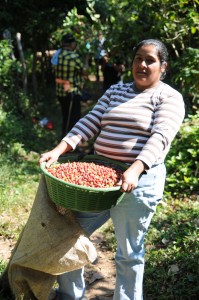 This woman didn’t give me her name. She’s a coffee bean worker in the mountains of El Salvador. For the back breaking work she is doing, to fill her one basket, she’ll receive $1.25 for one basket which will go toward her family and their livelihood. Even in her work, she still made time to talk with women from the United States, welcome us to her land, and help us in our learning how to pick coffee beans. I didn’t inquire about her education nor did I consider it important to ask if she was a blogger or social media buff. She assisted us throughout the day, offering us worn seats and introducing us to her family. Her smile could light up one side of a mountain.
This woman didn’t give me her name. She’s a coffee bean worker in the mountains of El Salvador. For the back breaking work she is doing, to fill her one basket, she’ll receive $1.25 for one basket which will go toward her family and their livelihood. Even in her work, she still made time to talk with women from the United States, welcome us to her land, and help us in our learning how to pick coffee beans. I didn’t inquire about her education nor did I consider it important to ask if she was a blogger or social media buff. She assisted us throughout the day, offering us worn seats and introducing us to her family. Her smile could light up one side of a mountain.
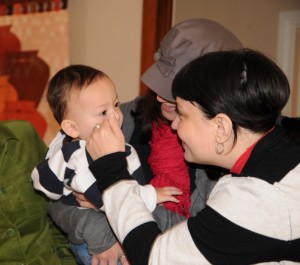 This is Detroit based Adele Nieves (on the right) who is stroking the cheek of my son, Isaiah. Adele is an amazing community organizer, activist, and world traveler. Her journalism reflects her professional ethos of love-centered labor. She spends her time traveling to conferences to document the global movement of all women, learning more about their traditions and culture so she is well-versed in the many tongues of feminisms. She becomes a tia (aunt) to the children of those she loves, caring for them, and welcoming them to the world of hope and struggle. From interviews to spoken word, from Africa to Atlanta, Adele connects with whomever is in her presence.
This is Detroit based Adele Nieves (on the right) who is stroking the cheek of my son, Isaiah. Adele is an amazing community organizer, activist, and world traveler. Her journalism reflects her professional ethos of love-centered labor. She spends her time traveling to conferences to document the global movement of all women, learning more about their traditions and culture so she is well-versed in the many tongues of feminisms. She becomes a tia (aunt) to the children of those she loves, caring for them, and welcoming them to the world of hope and struggle. From interviews to spoken word, from Africa to Atlanta, Adele connects with whomever is in her presence.
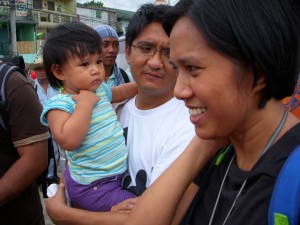 Jennifer Padilla, aka, Ate Pots [Ah-teh POTS] is a Filipina working on behalf of social injustices in the Philippines. She works with grassroots organizers in the Philippines and believes in the awesome power of the arts to transform the political and social ills of society. Her daughter, Gabby, is multilingual, and is often brought to rallies and marches, sessions and program with Ate Pots. Her spouse supports this integration of children and activism. Their entire family welcomes and supports US-activists who go the Philippines to learn more about the injustices of the government and their way of life.
Jennifer Padilla, aka, Ate Pots [Ah-teh POTS] is a Filipina working on behalf of social injustices in the Philippines. She works with grassroots organizers in the Philippines and believes in the awesome power of the arts to transform the political and social ills of society. Her daughter, Gabby, is multilingual, and is often brought to rallies and marches, sessions and program with Ate Pots. Her spouse supports this integration of children and activism. Their entire family welcomes and supports US-activists who go the Philippines to learn more about the injustices of the government and their way of life.
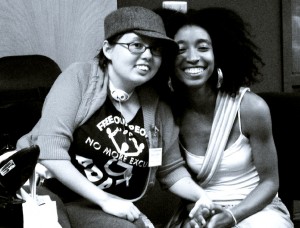 This is Stacy Milbern on the left and Alexis Pauline Gumbs on the right. Cripchick (Stacey Milbern) is “a powerchair-roaring, poetry-stringing, people power-dreaming disabled queer woman of color. After pouring the last five years of her life into organizing with the Disabled Young People’s Collective, she is currently taking a break from traditional organizing to write, make media and deepen relationships,” according to Ms. Cripchick herself. And Alexis Pauline Gumbs is busy “collecting and amplifying the social organizing herstories of black women, trans men, and gender queer visionaries who have been refusing the limits of heteronormativity and opening the world up by being themselves in the second half of the 20th century.”
This is Stacy Milbern on the left and Alexis Pauline Gumbs on the right. Cripchick (Stacey Milbern) is “a powerchair-roaring, poetry-stringing, people power-dreaming disabled queer woman of color. After pouring the last five years of her life into organizing with the Disabled Young People’s Collective, she is currently taking a break from traditional organizing to write, make media and deepen relationships,” according to Ms. Cripchick herself. And Alexis Pauline Gumbs is busy “collecting and amplifying the social organizing herstories of black women, trans men, and gender queer visionaries who have been refusing the limits of heteronormativity and opening the world up by being themselves in the second half of the 20th century.”
Who’s on your list?
Free Write on…”Recovery”
i keep using the word “recovery”
like i just went through something that caused trauma or pain, when in actuality, i went through something that made me feel more alive.
so, am i recovering from being alive? going back to being less alive or…?
i am recovering from exhaustion, dehydration, fatigue, being “on” the whole time (when you’re photographing, you are unrelenting in finding the perfect angle and light), and translating english-spanish/spanish-english.
i’m tired.
so tired, i’m not bothering with capitalization.
the longest separation from my son – 5 days – and the next morning, when i got him out of his crib, he just smiled and stared at me, like he couldn’t really believe i was there. and we sat together and talked. i told him about el salvador and the people i met there. he made noises and smiled. he showed me his newest milestone: clapping. i almost started crying. (…the tears never stop…)
when he napped, i stared at the ceiling of my bedroom. lying on my back, i examined how the walls met the ceiling perfectly. no gaps, no holes for water, light, animals, or insects to come through. no wind. nothing except a soft green painted wall and a creme colored ceiling. nick and i joke about our old windows being from the 1920s, but now i see an efficient window pane keeping all things that belong outside, outside.
i stared at my kitchen. the white shelves nick built for me that hold my spices, lentiles, dried fruits, and pasta. the abundance spoke to me in new ways.
chiltiupan has nothing in abundance. and in the five days i spent walking the mountain roads, my leg muscles were hardened from the terrain. here i only have smooth wooden steps that take me upstairs. no dusty roads or lopsided cobblestone pathways. here we have an old, worn lawn mower (probably in its last days) that can barely make the turn to go in another direction. in chiltiupan, there are machetes to cut brush, apples, animals, and trees.
i tell people that when you travel to economically underdeveloped countries to not waste your time on guilt. guilt is a self-indulgent emotion when left alone too long. it leads to unproductive action geared toward what will relieve your guilt instead of utilizing your privilege and power to be used for something helpful, something that will relieve the violence, poverty, and injustice.
stop the guilt. start believing. start acting. start thinking. collaborate, be joyful, be useful, let yourself be transformed so your relationships are more than just words of love, but are action based foundations of love.
remove “feeling bad” for what you have and, instead, use what you’ve been given for good. what good comes from “feeling bad?”
more action is done from joy and understanding than guilt and bad feelings. they steer you toward charity, not justice.
it’s not enough to go to the poor corners of the world and feel peaceful because of their smiles. it’s not enough to wonder how “they” survive and leave money in their hands. it’s not enough to get on a plane and tell your friends that the people are wonderful.
what is enough?
it is a question only you can answer yourself. it is a question between you and Whom/Whatever you pray to at night.
One Camera, A Thousand Hearts
I was seventeen when photography lured me into the world of light, shadow, color, and movement. Pretty pictures. Everyone likes pretty pictures. Everyone loves sunsets and gardens, children, and triumphant moments. Documented agony at the finish line or a warrior athlete are crowd favorites.
But I never grasped the power of portrait until now.
I just returned from a 5 day trip the moutainous community of Chiltiupan, El Salvador. I will be writing more later, but here are a few bread crumbs as an appetizer…
Truthout About Kyriarchy: An Open Letter To “Feminist” Writers, Bloggers, and Journalists
In April 2008, I wrote a post on my blog about and introduced the word “kyriarchy.” At the time, I was writing in response to a feminist blogosphere blow-up. The feminist blogosphere in April of 2008 was busy unveiling the torrent history of feminist-identified white women writers and presses co-opting and adopting the work of women of color writers, and ignoring the lines of power and oppression between women. Or, in other words, it was about the long history of white women acting as the authority on subject matter that clearly were out of their lines of experience.
And then it resulted in an unprecedented fallout when Seal Press, whose tagline is “publishing ground-breaking books by women, for women” publicly disgraced itself by insulting women of color writers and bloggers.
It was because of these incidents, I began thinking of kyriarchy.
I studied in one of Elisabeth Schussler Fiorenza’s classes, one of the most searing feminist theologians of our time, and, afterward, took a personal vow and role of academic vigilante. Such thoughts and transformative insights, I thought, should be made available to those outside the ivory tower. I began incorporating kyriarchy into my poems, criticizing the criminal cost and hoarding of knowledge by universities. I even dipped into recorded spoken word, which resulted in a CD compilation of work by other women of color. The CD was used as a fundraiser to financially assist mothers to get to a powerful Allied Media Conference in Detroit. Kyriarchy became the bedrock of my activism.
That was the origin of bringing kyriarchy out of the academic walls and into the blogosphere; that it would be (more) available. I thought that by offering a new term for folks to chew on, a deeper understanding of who we are and why we are the way we are would bubble. At the very least, an on-going and informal conversation of patriarchy vs. kyriarchy would be achieved.
To date, the piece about kyriarchy is correctly linked and cited by nearly fifty articles and posts, and one urban dictionary even added “kyriarchy” to its pages. It became apparent that kyriarchy, a neologism by Elisabeth Schussler Fiorenza, caught fire. A few months after writing about kyriarchy, I was contacted by the research assistants of feminist writer, Shira Tarrant, who asked for permission to use my name and properly cite my work in her forthcoming book, Men and Feminism. I gave my permission, reminding the author that the term was clearly not my own, just my effort to bring the compelling word to a non-academic audience.
I was ecstatic it was so well-received by so many different circles of thought.
And then two months ago, I received a link to a recently published article in The Guardian entitled, “The Patriarchy is Dead, But the Kyriarchy Lives On,” by Nichi Hodgson. After reading it, two questions immediately popped in my head: “How is this article covering the emergence of kyriarchy in the feminist sphere with not one attribution and where had she learned it from?” and “What have I done?”
(I’ll tackle the second question first because it’s ten fold more important than the first.)
Hodgson pats kyriarchy down to a nice and quasi-intelligent term that relegates the freedom to complain about oppression to include The Men, too. It turns a highly flexible academic term by a feminist theologian into a pop cultured meat loaf: a soft, feel good term that everyone can chew and swallow.
Hodgson uses the pornography industry as an example to illustrate kyriarchy’s clarifying power. She posits that both women and men are exploited by the porn industry. With kyriarchy as your scapel, you can see how: not only are women exploited and objectified (who could potentially benefit and profit from this work) while men, with their overexposure to the X-rated world, may experience problems keeping their sexual organs and libido “up” in high gear.
And then Hodgson makes a common and dangerous jump about kyriarchy and contemporary feminisms in general:
It helps us to recognise the interconnection of education, class and eating disorders such as anorexia, and of domestic violence and poverty, rather than encouraging us to indiscriminately blame men.…
It helps to explain how women themselves can in some cases morph into the supremacist bully, when paranoid mothers pass on anxieties about food and bodies to their daughters, ground down themselves by years of trying to live up to constructed notions of beauty.
The purpose and measure of kyriarchy – and feminism in general – is not to increase our time at the microphone so we can more accurately assign BLAME. The purpose and measure of kyriarchy is to further understand the power and crippling tendencies of the human race to push, torture, and minimize others. It is in our nature to try and become “lord” or “master” in our communities, to exert a “power-over” someone else. Kyriarchy does not exist to give us tools to further imprison ourselves by blaming our environment, upbringing, or social caste. It is the opposite. Kyriarchy exists to give us tools to liberate ourselves by understanding the shifting powers of oppression. It is not about passing the megaphone to men so they can be included in the oppression olympics. Simply check-marking our gender, sex, race, ablity, class, citizenship, skin color and other pieces of identity will not free us from the social ills of our stratified society. Kyriarchy is not the newly minted alarm clock to wake us up to what’s wrong. It exists to radically implement our finest strategies to deconstruct our personal and political powers for the liberation of self and community. For self AND community.
Which is why I so vehemently disagree with Hodgson who believes that the most helpful piece of kyriarchy is “its emphasis on individual liberation…”
Please indulge my own theory-making right now: There’s no such thing as liberation if the word ‘individual’ precedes it.
I cannot speak for Elisabeth Schussler Fiorenza. I cannot pretend to even guess what Hodgson herself means in writing that phrase “individual liberation.” However, in the spirit of feminist theology, in the spirit of radical understanding of power, I would argue with 100% confidence that the absolute LAST thing that kyriarchy strives for is individual liberation. Solely pursuing your own liberation often comes at the expense of others. That’s not liberation, that’s mainstream feminism.
Which brings me to the second question, and my personal slant/issue on this article: where did Hodgson find kyriarchy and, knowing the migration of this term from the ivory tower to the digital masses, why is there no attribution?
After I send my message to The Guardian, in which I congratulate her for the published article, but state my concerns and ask why her references are not included, Hodgson acknowledges my message and promises to reply in a few days when she is more readily available.
A reply lands in my inbox after a few more days in which she explains her source, which is the book by Shira Tarrant, who she makes no mention of and is the author who had contacted me to cite my work on kyriarchy, and some of Schussler Fiorenza’s original texts. Hodgson, upon rechecking Tarrant’s book, acknowledges my name in the credits to which she offers a sincere apology if I “felt plagarized.” It concludes with a request to list where my other work is so – the next time – she can properly include my name. I wanted to ask, “You mean other than the “FAQ” section of my website where it’s the first term under my own lexicon?”
“Felt plagarized?” What I found most ironic is that I was brought back to 2008, to the originating circumstances of what drove me to introduce kyriarchy to the US feminist blogosphere: the blantant and irresponsible disregard for (at minimum) thorough research and (at best) moral and ethical journalism. But, for me, this incident just tacked itself in the ongoing practice of appropriating, ignoring, and assuming authority on and of the work of women of color by feminist-identified white women. Or, as Hodgson writes:
Perhaps most importantly, kyriarchy exposes a sin within the women’s movement itself: that of feminist-perpetuated oppression.
Got Inspiration?
Me: I think one of the scariest things is to think of myself at 70, unsuccessful in trying to write and finding nothing good coming from me. I’m just going to feel like shit.
Nick: Well, try to think of yourself at 70 and not having tried at all and finding you still feel like shit.
